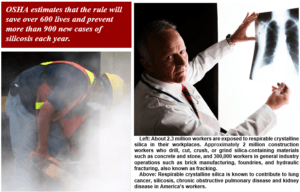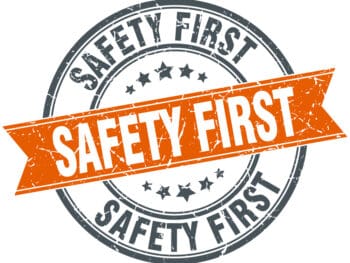
The rule is comprised of two standards, one for Construction and one for General Industry and Maritime. The Final Rule is projected to provide net benefits of about $7.7 billion annually.
2.3 Million Workers Exposed to Respirable Crystalline Silica
About 2.3 million workers are exposed to respirable crystalline silica in their workplaces, including 2 million construction workers who drill, cut, crush, or grind silica-containing materials such as concrete and stone, and 300,000 workers in general industry operations such as brick manufacturing, foundries, and hydraulic fracturing, also known as fracking. Responsible employers have been protecting workers from harmful exposure to respirable crystalline silica for years, using widely-available equipment that controls dust with water or a vacuum system.
The U.S. Department of Labor first highlighted the hazards of respirable crystalline silica in the 1930s, after a wave of worker deaths.
The department set standards to limit worker exposure in 1971, when OSHA was created. However, the standards are outdated and do not adequately protect workers from silica-related diseases. Furthermore, workers are being exposed to silica in new industries such as stone or artificial stone countertop fabrication and hydraulic fracturing.
A full review of scientific evidence, industry consensus standards, and extensive stakeholder input provide the basis for the final rule, which was proposed in September 2013.
The rule-making process allowed OSHA to solicit input in various forms for nearly a full year. The agency held 14 days of public hearings, during which more than 200 stakeholders presented testimony, and accepted over 2,000 comments, amounting to about 34,000 pages of material.
Enhanced Employer Flexibility In Choosing How To Reduce Levels
In response to this extensive public engagement, OSHA made substantial changes, including enhanced employer flexibility in choosing how to reduce levels of respirable crystalline silica, while maintaining or improving worker safety.
Both standards contained in the final rule took effect on June 23, 2016, after which industries have one to five years to comply with most requirements, based on the following schedule:
- Construction will have until June 23, 2017, one year after the effective date, while General Industry and Maritime will have until June 23, 2018, two years after the effective date.
- Hydraulic fracturing has until June 23, 2018, two years after the effective date for all provisions except Engineering Controls, which require compliance by June 23, 2021.
OSHA approved State Plans have six months to adopt standards that are at least as effective as federal OSHA standards. Establishments in states that operate their own safety and health plans should check with their State Plan for the implementation date of the new standards.
Author Bob Bower, Medcor, Director of Operations. Medcor helps employers reduce the costs of workers’ compensation and general health care by providing injury triage services and operating worksite health and wellness clinics. Medcor’s services are available 24/7 nationwide for worksites of any size in any industry. Headquartered in McHenry, Illinois, the company operates 174 clinics and provides triage services to over 90,000 worksites across all 50 states and US territories. Medcor’s triage methods are covered by U.S. & foreign patents, including U.S. No. 7,668,733; 7,716,070; & 7,720,692; other patents pending. Medcor is privately held. Learn more at www.medcor.com.










